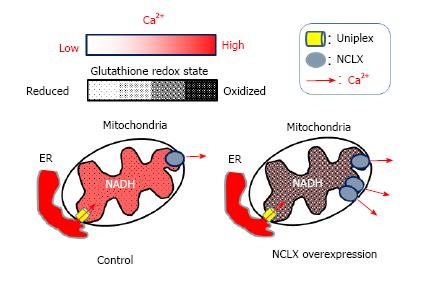Copyright
©The Author(s) 2015.
World J Biol Chem. Nov 26, 2015; 6(4): 310-323
Published online Nov 26, 2015. doi: 10.4331/wjbc.v6.i4.310
Published online Nov 26, 2015. doi: 10.4331/wjbc.v6.i4.310
Figure 3 Proposed model for the modulation of the matrix redox signaling by mitochondrial Ca2+.
After cell stimulation, Ca2+ released from the endoplasmic reticulum (ER) enters in mitochondria by the mitochondrial uniplex (left), stimulating matrix Ca2+-dependent dehydrogenases, which increase NADH levels and promoting a reduction of the mitochondrial glutathione pool. In cells over-expressing the mitochondrial Na+/Ca2+ exchanger (NCLX, right) Ca2+ extrusion is more efficient and therefore Ca2+-dependent dehydrogenases less activated. Such lowering the mitochondrial Ca2+ response blunts NADH formation and prevents matrix redox changes of the mitochondrial glutathione pool. NADH: Reduced form of nicotinamide-adenine dinucleotide; NCLX: Mitochondrial Na+/Ca2+ exchanger.
- Citation: Santo-Domingo J, Wiederkehr A, De Marchi U. Modulation of the matrix redox signaling by mitochondrial Ca2+. World J Biol Chem 2015; 6(4): 310-323
- URL: https://www.wjgnet.com/1949-8454/full/v6/i4/310.htm
- DOI: https://dx.doi.org/10.4331/wjbc.v6.i4.310









